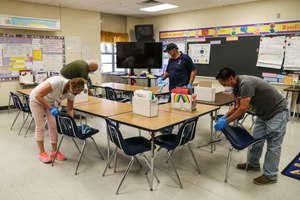
Funding is available for continuing and improving distance learning, amping up cybersecurity measures, cyberbullying prevention and more
March 2020 was the first March without a school shooting in the U.S. since 2002 .This was an unintended but welcome outcome since schools across the nation were closed as a preventative measure to slow the spread of coronavirus.
And now that summer break is on the horizon, it is the perfect time to review school safety and the Coronavirus Aid, Relief, and Economic Security (CARES) Act grants . Use this stretch to harden your schools, develop distance learning plans and strive for a safe school year whether it is at school or through online education.
U.S. Secretary of Education Betsy Devos announced that more than $300 million in grants will soon be available to help states “create adaptable, innovative learning opportunities for K-12 and postsecondary learners.” The CARES Act Higher Education Emergency Relief Fund ( HEERF ) provides grants to institutions of higher education (IHEs) so they can financially assist students who have been negatively impacted by COVID-19. These emergency relief funds also include grants for historically Black colleges/universities, tribally controlled colleges/universities, minority serving institutions, Strengthening Institutions Program and the Fund for the Improvement of Postsecondary Education ( FIPSE ).
The CARES Act Elementary and Secondary School Emergency Relief Fund ( ESSER Fund ) allocates $13.2 billion towards state education agencies (SEAs) to mitigate the effects of COVID-19 on local education agencies (LEAs) and charter schools. The CARES Act delivers $307.5 million for school grants; this is divided into two arenas:
A novel approach to school safety and security is to continue and enhance distance learning . The Rethink K-12 Education Models Grant offers grants to school districts for virtual learning and course access programs. This grant will:
The Reimagining Workforce Preparation Grant “expands short-term postsecondary programs and work-based learning programs.” This grant is designed to catalyze the economy and help Americans get back to work. It is also intended to help small businesses .
The United States Department of Agriculture (USDA) Rural Development Initiative “provides loans and grants” to support “infrastructure improvements” for schools and high-speed Internet access in rural areas.
An USDA state by state map assists in whittling down prospective grants. For example; the State of New York lists seven key programs in Rural Development; of interest is the Community Facilities Direct Loan & Grant . This grant allows “improvements in essential community facilities, to purchase equipment, and to pay related project expenses.” This grant is ideal to develop and improve your current computer technologies.
A presentation to the Red Hook, New York Central School District Board of Education on March 25, 2020 went awry. “Inappropriate images" popped up on the district clerk's screen, “prompting her to restart the board's first virtual meeting.” The nationwide lockdown turned everyday meetings into a virtual whirlwind where anything can happen. Cybersecurity is now in the forefront , and school districts are trying to catch up.
The 2020 CARES Act Governor’s Emergency Education Relief (GEER) fund provides $3 billion dollars to SEAs via the Governor’s office. SEAs disseminate grants to LEAs “to support technological capacity and access, including hardware and software, connectivity, and instructional expertise," as well as cybersecurity. Are you cybersecurity ready?
Look at a social media site, and you will find cyberbullying around every corner. During this past month, I vividly recall words like “low I.Q., dummy dope, truly weird, Lyin’ Ted Cruz, Sleepy Joe Biden, pathetic and low ‘class slob” on Twitter, or texted and sent around the globe through various other social media platforms.
In fact, one-fifth of all bullying occurs through social media. The current shutdown is a perfect storm for cyberbullying. Students being home alone, online school, zero or low consequences and anonymity are how cyberbullies prey on their victims.
The Highmark Foundation awards grants to tackle the cyberbullying phenomenon; they seek to “maintain a public health focus to bullying prevention that encourages learning.”
Policymakers from the federal to the school board level are influenced by their constituents through letters, petitions and the possibility of not being reelected. It is every person’s responsibility to contact their elected officials and open up channels of communication, research and write “ urgent request ” petitions and letters to your chosen politicians.
Pro tip : Start with your local school board and sway them. Move up the food chain to state legislatures with endorsements from your school board.
Copyright © 2025 GovGrantsHelp.com. All rights reserved.
